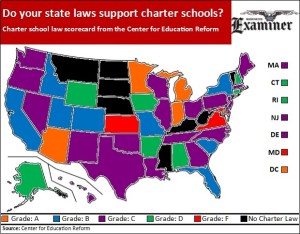Do your state laws support charter schools?
By Jason Russell
Washington Examiner
March 17, 2015
The Center for Education Reform released its 16th rankings of charter school laws in each state Monday. Minnesota beat Indiana, Michigan, and Arizona for state laws most supportive of charter schools. However, the District of Columbia had slightly better charter school laws than Minnesota.
“Strong charter laws feature independent, multiple authorizers, few limits on expansion, equitable funding, and high levels of school autonomy,” the accompanying report explained.
States were graded in four different areas. The more entities allowed to open a charter school, the better. Restrictions on the number of charter schools or number of students they can serve drive down a state’s score. Independence in making operating decisions improves a score. Equal and guaranteed funding for each charter school student versus all other public school students also raises a state’s grade.
Eight states have no laws allowing charter schools at all: Alabama, Kentucky, Montana, Nebraska, North Dakota, South Dakota, Vermont, and West Virginia.
According to the accompanying report, 2.9 million students attend roughly 6,700 charter schools in 42 states and the District of Columbia. That’s approximately 6 percent of the elementary and secondary student population in the country.
The Midwest appears to be the region most friendly to charter schools. Indiana, Michigan, and Minnesota all earn A grades for their charter school laws. No other Midwest state earns a grade lower than C.
Outside the Midwest, the regions are surprisingly diverse. In the Northeast, New York gets a B grade, the best of any Northeast state. The South has a few B states in Florida and South Carolina, but Mississippi has no charter laws at all. Four Plains states have no charter laws at all, and Kansas gets an F grade — but then four other Plains states get a B grade.
Charter schools are publicly-funded schools that don’t charge tuition and are open to all students, but have more independence in their operations and curriculum than traditional public schools.















